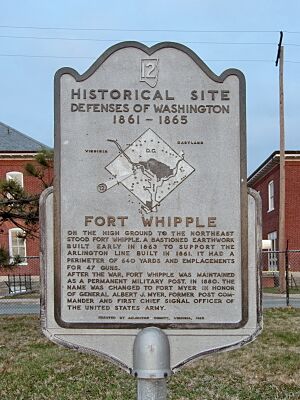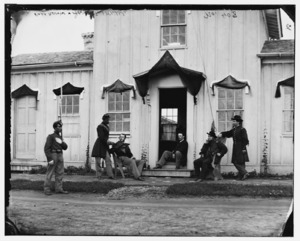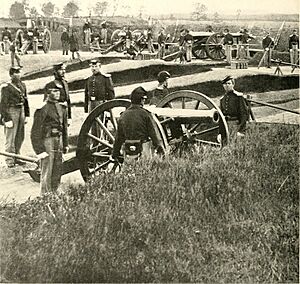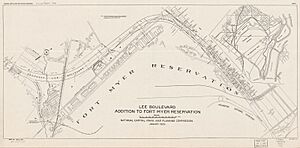Fort Myer facts for kids
|
Fort Myer Historic District
|
|
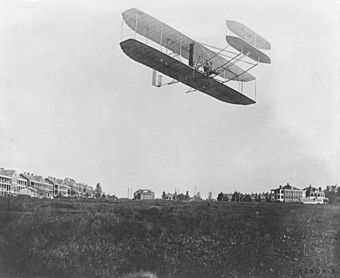
Orville Wright flying at Fort Myer
September 9, 1908 |
|
| Location | Arlington County, Virginia |
|---|---|
| Built | 1861 |
| Architect | US Army |
| Architectural style | Late Victorian |
| NRHP reference No. | 72001380 |
Quick facts for kids Significant dates |
|
| Added to NRHP | November 28, 1972 |
| Designated NHLD | November 28, 1972 |
Fort Myer was once a very important U.S. Army base located right next to Arlington National Cemetery in Arlington County, Virginia. It's also just across the Potomac River from Washington, D.C.. This military post started during the American Civil War as two smaller forts, Fort Cass and Fort Whipple. In 2005, it joined with a nearby Marine Corps base called Henderson Hall. Today, it is known as Joint Base Myer–Henderson Hall.
Contents
History of Fort Myer
How Fort Myer Began
In 1861, the land where Fort Myer now stands was part of a large estate. This estate belonged to Mary Anna Custis Lee, who was the wife of Robert E. Lee. The Lee family lived there when Robert E. Lee was not away serving in the military.
When the American Civil War started, the state of Virginia left the United States. Robert E. Lee also left his position in the U.S. Army. He and his wife then moved away from their estate. The United States Government then took over the estate. They started using it for several important purposes:
- As a burial ground for soldiers who died fighting for the Union Army. This area later became Arlington National Cemetery.
- As a place for formerly enslaved people to live, known as Freedmen's Village.
- For military purposes, including building defenses to protect Washington, D.C. These were part of the Civil War Defenses of Washington.
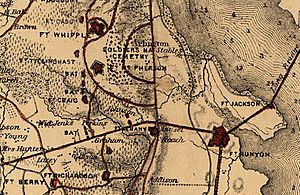
Fort Cass: Early Defenses
After the Union Army lost the First Battle of Bull Run in July 1861, they quickly built a small fort in August 1861. This fort was called Fort Ramsay at first. It was one of the first defenses built in the area to protect Washington, D.C.
This fort was later renamed Fort Cass. It was shaped like a crescent and had enough space for 12 cannons. Even though the Army stopped using Fort Cass in 1865 when the Civil War ended, the United States Department of War (which is now the Department of Defense) continued to own the land.
Fort Whipple: A Stronger Fort
In August 1862, the Union Army faced another defeat at the Second Battle of Bull Run. Because of this, they built an even stronger fort called Fort Whipple in the spring of 1863. This new fort was a short distance southeast of Fort Cass.
The Army named Fort Whipple after Brevet Major General Amiel Weeks Whipple. He was a brave officer who died in May 1863 from injuries he received during the Battle of Chancellorsville. Fort Whipple was considered one of the strongest forts built to defend Washington during the Civil War. It was much larger than Fort Cass and could hold 43 cannons.
When the Civil War ended in 1865, the fortifications at Fort Whipple were no longer needed. The fort then became home to the Signal School of Instruction for Army and Navy Officers, which started in 1869.
Fort Myer: A New Era Begins
On February 4, 1881, the military post that included Fort Whipple was renamed Fort Myer. This was done to honor Brigadier General Albert J. Myer. General Myer had been in charge of the Signal School of Instruction for Army and Navy Officers from 1869 until he passed away in August 1880.
Since then, Fort Myer has been an important base for the Army's Signal Corps. It also became a famous place for the U.S. Army's cavalry (soldiers who fought on horseback). Since the 1940s, it has been home to the Army's special ceremonial units. These include The United States Army Band (also known as "Pershing's Own") and the 3rd U.S. Infantry Regiment (known as "The Old Guard").
General Albert J. Myer also started the National Weather Service at Fort Myer in 1870. This service helps us get weather forecasts today.
First Military Flight
Fort Myer was the location of the very first flight of an aircraft at a military base. In 1908, Orville Wright, one of the famous Wright brothers, made several demonstration flights there.
Sadly, on September 17, 1908, Fort Myer became the site of the first death in a powered airplane. During a demonstration flight with Orville Wright, at about 100 feet in the air, a propeller broke. This caused the aircraft to go out of control and crash. Lt. Thomas Selfridge suffered a serious head injury and later died. He was the first person to die in a fixed-wing aircraft. Orville Wright was also badly hurt, with broken ribs and a leg injury.
Important Homes and Communications
Quarters One at Fort Myer was originally built for the base commander. Since 1908, it has been the home of the Chief of Staff of the United States Army. Every Chief of Staff since then has lived there, except for General John J. Pershing.
In 1913, the United States Navy built the nation's first radio communication station, NAA, near Fort Myer. In 1915, the station's tall radio towers, known as "The Three Sisters," sent the first wireless message across the Atlantic Ocean all the way to Paris.
Fort Myer During World Wars
During World War I, Fort Myer was a key place for gathering and training many military units. These included engineering, artillery, and chemical companies and regiments. The area where the Andrew Rader Health Clinic and the Commissary are now located was turned into a training ground for trench warfare. French officers taught American soldiers how to fight in trenches there.
General George S. Patton Jr., a very famous military leader, was stationed at Fort Myer four different times. After World War I, he started a charity event called the "Society Circus." He later became the Post Commander and led the 3rd Cavalry Regiment, which was based at Fort Myer from the 1920s until 1942. At that time, the regiment moved to Georgia to become mechanized, meaning they switched from horses to vehicles.
In late 2001, after the September 11th attacks, troops were temporarily housed at Fort Myer. These troops were part of an operation called Operation Noble Eagle. They included active duty and National Guard Military Police units from all over the country. The last of these deployed responders left Fort Myer in 2005.
Joint Base Myer–Henderson Hall: A Combined Force
In 2005, a special government plan was put in place to make military operations more efficient. As a result, the Army's Fort Myer and the Marines' Henderson Hall became the first "Joint Base" in the United States Department of Defense.
This new base, called Joint Base Myer–Henderson Hall (JBMHH), includes military facilities at Fort Myer, Henderson Hall, The Pentagon, and Fort Lesley J. McNair. These combined locations serve over 150,000 active duty military members, civilian employees of the Department of Defense, and retired military personnel in the region.
Commemorative Status
Fort Myer was recognized as a National Historic Landmark in 1972. This was because it has many well-preserved buildings for cavalry units and officers' homes. It is also important for its role in the early history of military aviation.
On September 1, 1970, the United States Postal Service released a special postcard to celebrate the 100th anniversary of Weather Services at Fort Myer.
A book called Images of America: Fort Myer has been published about the fort. This book even includes a copy of a handwritten letter from Abraham Lincoln. In the letter, Lincoln appointed General Whipple's oldest son to the United States Military Academy at West Point.
Images for kids




